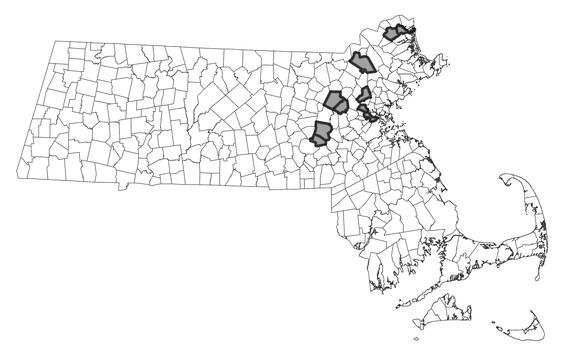- Scientific name: Cyperus engelmannii
- Species of Greatest Conservation Need (MA State Wildlife Action Plan)
- Threatened (MA Endangered Species Act)
Description
Engelmann’s flatsedge is an annual member of the sedge family (Cyperaceae) found on pond shores and disturbed muddy areas. It stands 10-50 cm (4–20 in) tall, with leaves that are 2-10 mm (0.08-0.4 in) wide, 5-30 cm (2-12 in) long, and V- or M-shaped in cross-section. The species is named for German-American botanist George Engelmann (1809-1884).
Identification of species in the genus Cyperus can be difficult, and a technical manual should be consulted. Like other Cyperus species, Engelmann’s flatsedge has “spikelets” comprised of elongate clusters of small, inconspicuous flowers and subtending scales. The flowers and scales are arranged in two vertical rows along the axis of the inflorescence, giving the flowering stems a flattened appearance. Engelmann’s flatsedge is one of a few annual Cyperus species with three-cleft styles and three-sided achenes (dry, one-seeded fruits). Annuals can be recognized by their soft stem bases and fibrous root systems, lacking the underground nutrient-storing structures (rhizomes, tubers, or corms) and firm stem bases characteristic of perennials. The floral scales of Engelmann’s flatsedge are appressed (not outcurved at the tips), have seven or more nerves, are generally 2 to 2.8 mm (0.08-0.11 in) long, and do not overlap (the tip of each scale does not reach the base of the next scale on the same side of the spikelet).
The two species most likely to be confused with Engelmann’s flatsedge are straw-colored flatsedge (Cyperus strigosus) and saltmarsh flatsedge (C. odoratus). Straw-colored flatsedge is a common, short-lived perennial without well-developed rhizomes; it sometimes flowers in its first year and may be mistaken for an annual. Its stems usually have a swollen, corm-like base, and it has longer floral scales (usually 3.2-4.5 mm [0.13-0.18 in]) than Engelmann’s flatsedge or saltmarsh flatsedge. In addition, mature spikelets of the latter two species disarticulate into segments, whereas those of straw-colored flatsedge disarticulate from the base and fall from the plant in one piece. Saltmarsh flatsedge, which is on the Massachusetts Watch List, has floral scales that overlap and achenes that are shorter (avg. 1.2 mm [0.05 in]) than Engelmann’s flatsedge (1.8 mm [0.07 in]). The floral scales of saltmarsh flatsedge are also often papery in texture, whereas they are leathery in Engelmann’s flatsedge.
Life cycle and behavior
This is an annual sedge.
Population status
Engelmann’s flatsedge is listed under the Massachusetts Endangered Species Act as Threatened. All listed species are protected from killing, collecting, possessing, or sale and from activities that would destroy habitat and thus directly or indirectly cause mortality or disrupt critical behaviors. Engelmann’s flatsedge occurs in Middlesex and Essex Counties.
Distribution and abundance
Engelmann’s flatsedge occurs from Minnesota to Massachusetts, south to Nebraska, Tennessee, and Virginia. It is listed as rare in Pennsylvania, Threatened in Massachusetts, and Special Concern in Tennessee.

Distribution in Massachusetts
1999-2024
Based on records in the Natural Heritage Database
Habitat
Most occurrences of Engelmann’s flatsedge in Massachusetts are along wet pond shores, which may be muddy, sandy, or pebbly. It also is found on the muddy tidal shores of the Merrimack River, and in one case in the soft, black mud of a pond bottom. It often grows along with other, more common, Cyperus species, including straw-colored flatsedge.
Healthy habitats are vital for supporting native wildlife and plants. Explore habitats and learn about conservation and restoration in Massachusetts.
Threats
Trampling and invasive exotic plants that can threaten these plants have been noted at some sites where they occur in Massachusetts. Alteration of hydrological conditions may threaten existing populations.
Conservation
As for many rare species, exact needs for management of Engelmann’s flatsedge are not known. However, management should strive to maintain natural hydrologic regimes, minimize competition with invasive plants, and prevent trampling from recreational and development activities. All active management of rare plant populations (including invasive species removal) is subject to review under the Massachusetts Endangered Species Act and should be planned in close consultation with MassWildlife’s Natural Heritage & Endangered Species Program.
References
Gleason, H. A., and A. Cronquist. 1991. Manual of Vascular Plants of Northeastern United States and Adjacent Canada, 2nd edition. The New York Botanical Garden, Bronx, NY.
Haines, A. 2011. Flora Novae Angliae – a Manual for the Identification of Native and Naturalized Higher Vascular Plants of New England. New England Wildflower Society, Yale Univ. Press, New Haven, CT.
Mears, R. L., and G. W. Libby. 1995. New Records of Cyperus (Cyperaceae) from Kentucky. Castanea 60: 79–82.
Michigan Flora Online. A. A. Reznicek, E. G. Voss, & B. S. Walters. February 2011. University of Michigan. http://michiganflora.net/information.aspx
Contact
| Date published: | April 14, 2025 |
|---|